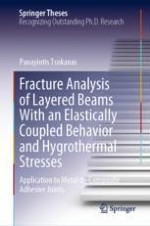2023 | OriginalPaper | Buchkapitel
2. The Effect of Residual Hygrothermal Stresses on the Energy Release Rate and Mode Mixity of Interfacial Cracks in Beams with Bending–Extension Coupling
verfasst von : Panayiotis Tsokanas
Erschienen in: Fracture Analysis of Layered Beams With an Elastically Coupled Behavior and Hygrothermal Stresses
Aktivieren Sie unsere intelligente Suche, um passende Fachinhalte oder Patente zu finden.
Wählen Sie Textabschnitte aus um mit Künstlicher Intelligenz passenden Patente zu finden. powered by
Markieren Sie Textabschnitte, um KI-gestützt weitere passende Inhalte zu finden. powered by
